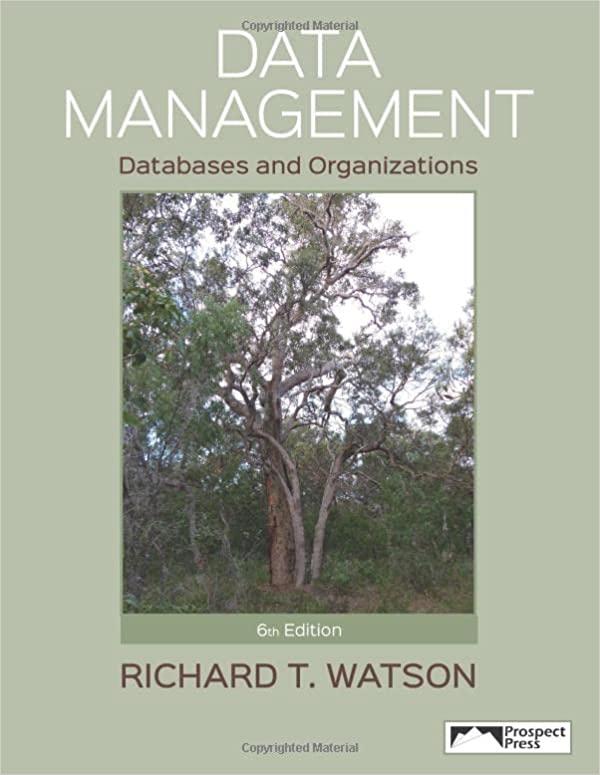Answered step by step
Verified Expert Solution
Question
1 Approved Answer
A special operation, called JOIN combines this sequence into a single operation Group of answer choices True False Flag question: Question 1 2 Question 1
A special operation, called JOIN combines this sequence into a single operation
Group of answer choices
True
False
Flag question: Question
Question pts
IN CARTESIAN or CROSS PRODUCT Operation The two operands have to be "type compatible
Group of answer choices
True
False
Flag question: Question
Question pts
The number of tuples in the result of projection pR is always greater or equal to the number of tuples in R
Group of answer choices
True
False
Flag question: Question
Question pts
The project operation removes any duplicate tuples
Group of answer choices
True
False
Flag question: Question
Question pts
PROJECT Operation is denoted by pi pi
Group of answer choices
True
False
Flag question: Question
Question pts
The Project operation is used to select a subset of the tuples from a relation based on a selection condition.
Group of answer choices
True
False
Flag question: Question
Question pts
Relational algebra expression is a sequence of relational algebra operations forms
Group of answer choices
True
False
Flag question: Question
Question pts
The RENAME operator is denoted by r rho
Group of answer choices
True
False
Flag question: Question
Question pts
In Relational Algebra both union and intersection are commutative
Group of answer choices
True
False
Flag question: Question
Question pts
In Relational Algebra minus operation is commutative
Group of answer choices
True
False
Flag question: Question
Question pts
In Relational Algebra both union and intersection are associative operations
Group of answer choices
True
False
Flag question: Question
Question pts
Entities are specific things or objects in the miniworld that are represented in the database.
Group of answer choices
True
False
Flag question: Question
Question pts
Attributes are properties used to describe an entity
Group of answer choices
True
False
Flag question: Question
Question pts
Composite and multivalued attributes may be nested arbitrarily to any number of levels, although this is rare.
Group of answer choices
True
False
Flag question: Question
Question pts
Entities with the same basic attributes are grouped or typed into an entity type
Group of answer choices
True
False
Flag question: Question
Question pts
The degree of a relationship type is the number of participating entity types.
Group of answer choices
True
False
Flag question: Question
Question pts
A relationship relates two or more distinct entities with a specific meaning
Group of answer choices
True
False
Flag question: Question
Question pts
In the Completeness Exhaustiveness Constraint, Total specifies that every entity in the superclass must be a member of some subclass in the specializationgeneralization
Group of answer choices
True
False
Flag question: Question
Question pts
Hierarchy has a constraint that every subclass has only one superclass called single inheritance; this is basically a tree structure
Group of answer choices
True
False
Flag question: Question
Question pts
A shared subclass is a subclass in more than one distinct superclasssubclass relationships
Group of answer choices
True
False
Flag question: Question
Question pts
In ER diagrams, we represent the relationship type as Diamondshaped box
Group of answer choices
True
False
Flag question: Question
Question pts
In a recursive relationship type both participation are same entity type in different roles.
Group of answer choices
True
False
Flag question: Question
Question pts
A specific entity does not have to have a value for each of its attributes.
Group of answer choices
True
False
Flag question: Question
Question pts
Each attribute does not have to have a value set or data type associated with it
Group of answer choices
True
False
Flag question: Question
Question pts
The attribute may not be composed of several components.
Group of answer choices
True
False
Flag question: Question
Question pts
Cardinality Ratio specifies minimum participationalso called participation constraint
Group of answer choices
True
False
Flag question: Question
Question pts
Existence Dependency Constraint specifies maximum participation
Group of answer choices
True
False
Flag question: Question
Question pts
An entity can exist in the database merely by being a member of a subclass; it must also be a member of the superclass
Group of answer choices
True
False
Flag question: Question
Question pts
Step by Step Solution
There are 3 Steps involved in it
Step: 1

Get Instant Access to Expert-Tailored Solutions
See step-by-step solutions with expert insights and AI powered tools for academic success
Step: 2

Step: 3

Ace Your Homework with AI
Get the answers you need in no time with our AI-driven, step-by-step assistance
Get Started


